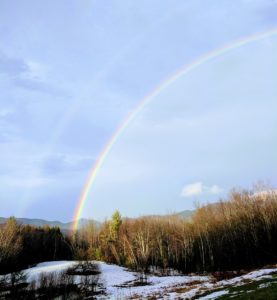This article was written by Rob Rives, former GMC education & volunteer coordinator, and previously appeared in the Summer 2019 Long Trail News.
 Early this year a popular hiking and running footwear manufacturer produced a short video describing the struggles that three of their sponsored athletes have with mental illnesses, including depression, anxiety, eating disorders, and post-traumatic stress from childhood trauma. Between scenes of running on picturesque mountain trails, the viewer hears their stories of recognizing, treating, and coping with mental illness. At the end of the video, the screen fades to black and a single sentence appears in white letters: “Talk about it.”
Early this year a popular hiking and running footwear manufacturer produced a short video describing the struggles that three of their sponsored athletes have with mental illnesses, including depression, anxiety, eating disorders, and post-traumatic stress from childhood trauma. Between scenes of running on picturesque mountain trails, the viewer hears their stories of recognizing, treating, and coping with mental illness. At the end of the video, the screen fades to black and a single sentence appears in white letters: “Talk about it.”
I felt called to battle. In this video, I saw reflections of myself: a person plagued by inner turmoil, looking for a way through daily walls of dark thoughts, and inextricably tied to a need for outdoor experiences as a coping mechanism and source of meaning.
As society is coming to realize, internalizing and ignoring mental health problems only makes them worse. Overcoming discomfort and discussing them, and facing facts, are the first steps in tackling a health crisis that costs billions of dollars and thousands of lives annually in the United States alone.
So, let’s talk about it: our collective mental health is getting worse but simply getting out the door and going for a walk can be a critical tool in reversing this trend, and you may be able to help someone by encouraging them to do so.
According to statistics compiled by the National Alliance on Mental Illness, approximately one in five adults in the U.S. experiences a mental illness in any given year, and one in five young people aged 13 to 18 will experience a severe mental disorder at some point during their lives. In 2015 only about half of the sufferers received mental health services in the preceding year. Of those who sought or received care, people of color received it at one-third to one-half the rate of their white counterparts.
A study published in early 2019 in the Journal of Abnormal Psychology showed a disturbing trend: between 2005 and 2017, rates of major depression symptoms rose by 63 percent in young adults (18 to 25 years old), and deaths from suicide increased by 56 percent during the same time period among 18- to 19-year olds. Rates of suicide among military veterans, both young and old, are also on the rise.
Given these data, it is fortunate that the social stigma of mental illness is gradually receding. Research on the personal and societal effects of mental illness has never been more prolific, workplaces more frequently provide access to care and services, and the U.S. has designated May as Mental Health Awareness Month.
Mental illnesses can’t be cured in the traditional sense. So we must arm ourselves with tools to treat, manage, cope, recover, and find ways forward to fulfilling lives. The toolbox can include individualized therapy, medication, a healthy diet, supportive networks, and my favorite: physical exercise, particularly among the trees, rocks, water, and sunshine of Vermont’s mountains.
Time in the sun may be more protective against mental (and other) illnesses than has been thought. According to a 2008 article from the National Institutes of Health journal Environmental Health Perspective, sufficient sun exposure has the following beneficial effects: increased vitamin D production (which is needed by more than 1,000 genes in regulation of nearly every kind of tissue); reduced risks of certain cancers that are more common in northern regions; reduced inflammatory and autoimmune responses; reduced risk of high blood pressure; improved sleep cycles due to natural serotonin and melatonin production; and increased levels of endorphins in the blood.
Getting enough sun while avoiding sunburn can be difficult for folks with fair skin, but the dappled sunlight under Vermont hardwoods offers a nice balance.
Sunlight may be one reason we feel better after time outside, but what exactly is changing in the brain when we go for a long hike in the woods? Researchers at Stanford University recently studied the effects of walking in natural areas on a common indicator of depressive episodes: “rumination,” a thought pattern that focuses on negative aspects of the self.
Study participants who had no history of mental illness were assigned 90-minute walks in either an urban area with lots of traffic or a natural area away from roads. Those who engaged in the hike in the natural area reported fewer ruminative thoughts and, in brain scans before and after the walk, showed reduced blood flow to the subgenual prefrontal cortex, the area of the brain where rumination takes place. In such scans, blood flow reflects the intensity of mental activity.
This result supports a truth many of us know intuitively: when outdoors we feel more happy, calm, and healthy. Unfortunately, as society encourages longer hours at work and more time indoors attending to electronic vices, we need to remind each other to prioritize outings. For folks living with mental illness, friends who encourage time outside are even more important.

To illustrate this, let’s do a quick thought experiment. What are your goals or aspirations? Short-term, long-term, it doesn’t matter—take a second and list them in your head. How about your overall purpose in life? What do you feel called to do?
Construct a metaphorical path in your mind: the trail beneath your feet is your aspiration, the surrounding wilderness is the confusion and distraction of the world at large, each step along the trail is a goal met, and the mountain summit ahead represents the fulfillment and realization of your life’s purpose.
Every day you wake, break camp, and continue your hike. But the trail is gradually narrowing. Brush is growing in, impeding passage. The firm tread gives way to grass, then to rock and dead leaves. Disorientation sets in; the summit is no longer visible. In fact, nothing in the forest is distinguishable. There are no landmarks. It happened so gradually you didn’t think to consult a map or consider other routes. Maybe there weren’t any.
On this trail, you can’t turn around. The trailhead and the firm path behind you disappeared a long time ago. Fear, frustration, and eventually numb dissociation guide your movements. Sure, you can keep walking, but are you going anywhere? You feel hopelessly lost and very much alone.
You know how to use the map and compass in your pack, but you’ve been adrift so long it feels pointless to try. It takes longer and longer to raise yourself from the ground and continue each morning. As you step over a hollow fallen tree, you imagine lying down inside it and remaining there.
What I call “wilderness of the mind” is an interpretation of the world I inhabit some days. It is a hostile wilderness, very different from the exterior one that brings joy. It is only one of many possible metaphors for a single mental illness. Yet it illustrates a characteristic central to mental health ailments: a sense of isolation and helplessness, despite the knowledge of available self-help tools.
For example, I am keenly aware of how running and hiking in the mountains improves my mood and outlook on life, yet the effort required to simply open the door and step out is sometimes inexplicably unbearable, my will drained by numbness and perceived pointlessness. At these times I need external force: a kind face in the wilderness who opens my pack, withdraws the map and compass, and shows me that the mountain is still out there.
Given the frequency of mental illness, it is quite likely a friend or family member of yours suffers, feels alone, and could benefit from your companionship and a dose of time outdoors. Avoiding the topic won’t make it go away. So don’t be afraid. Talk about it.
To learn more about how to talk about mental illness, please visit the National Alliance on Mental Illness website.



















Leave a Reply